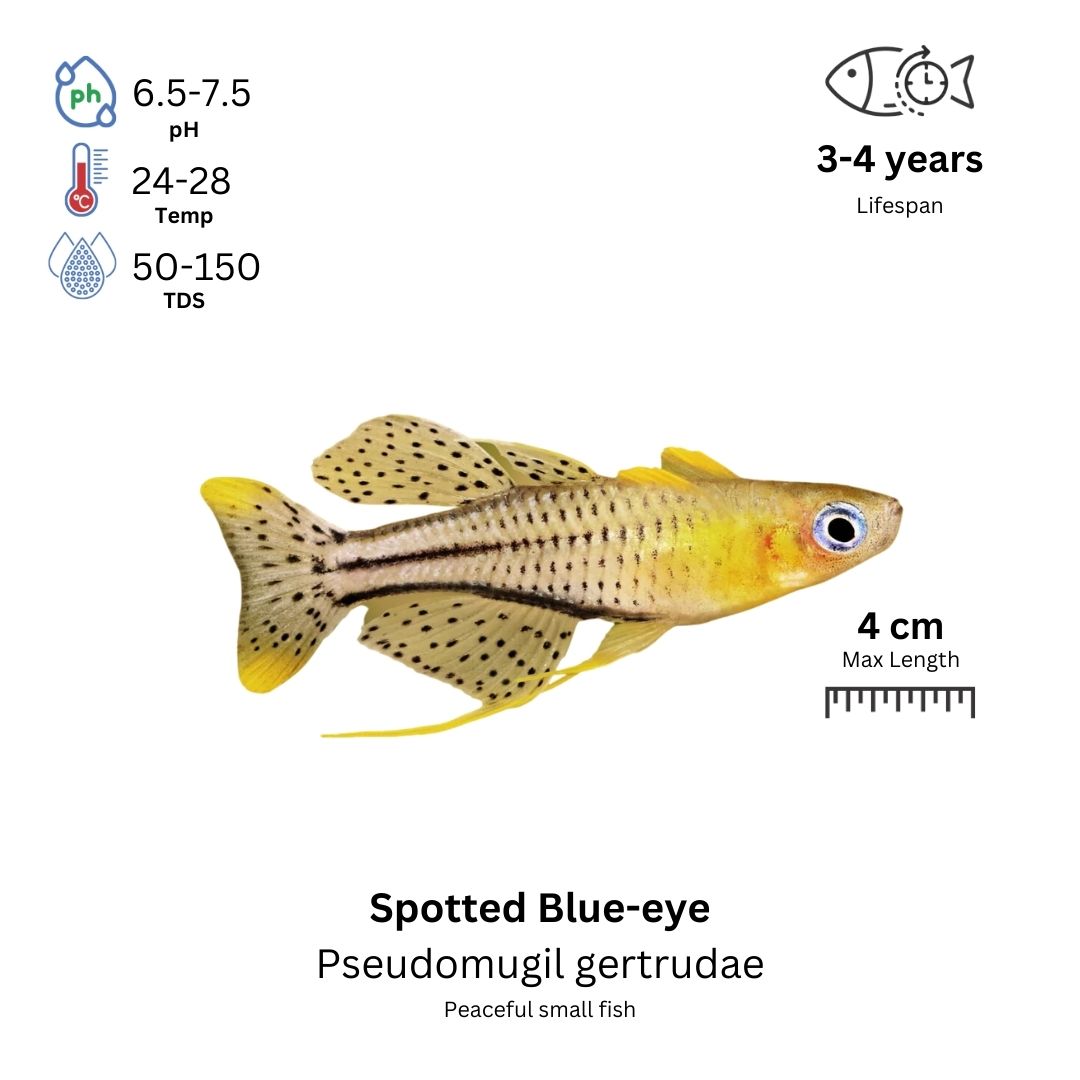Characteristics
The Spotted Blue-eye, scientifically named Pseudomugil gertrudae, is a stunning freshwater fish beloved for its unique appearance and manageable care requirements. It belongs to the family Melanotaeniidae and is a small, active species perfect for nano and planted aquariums. Its behavior is peaceful, making it ideal for community tanks with compatible species. Spotted Blue-eye thrives in water with a pH of 6.0–7.5, a temperature of 24–28°C (75–82°F), and moderate hardness. It is suitable for both beginner and experienced aquarists, given its adaptability to various conditions.
Origin and Distribution
The Spotted Blue-eye is native to northern Australia and New Guinea, where it inhabits slow-moving streams, wetlands, and shallow lagoons. These environments are typically rich in aquatic vegetation, providing both shelter and feeding grounds for the species. Their natural range highlights their adaptability to soft, acidic to slightly alkaline water.
Colors and Markings
This species is known for its shimmering blue eyes, which contrast beautifully against its translucent body. The body is decorated with fine black spots scattered across its fins and sides. Males exhibit brighter colors and elongated, ornate fins compared to females, adding to their appeal in aquariums.
Tankmates
Spotted Blue-eye is a peaceful species that thrives in groups of six or more. They are schooling fish and feel most comfortable in numbers. Ideal tankmates include other small, non-aggressive fish like Ember Tetras, Celestial Pearl Danios, and small Corydoras species. Avoid pairing them with larger, aggressive fish, as their small size makes them vulnerable.
Care Requirements
To maintain the health and vibrancy of the Spotted Blue-eye, provide a well-planted tank with plenty of swimming space. Floating plants and subdued lighting replicate their natural habitat and reduce stress. Regular water changes and stable water parameters are essential. An aquarium filter with gentle flow is recommended to avoid stressing the fish.
Diet and Feeding
Spotted Blue-eye are omnivores, feeding on small insects, crustaceans, and algae in the wild. In captivity, they thrive on a varied diet of high-quality flake food, micro-pellets, and live or frozen options like brine shrimp and daphnia. Feed them small portions multiple times a day for optimal health and coloration.
Gender Differences
Males are more vibrant and have longer, more elaborate fins compared to females. Their dorsal and anal fins are particularly pointed and decorated with striking patterns. Females are generally smaller with more subdued colors, making them easier to distinguish.
Breeding
Breeding Spotted Blue-eye in captivity can be rewarding. They are egg scatterers and prefer spawning among fine-leaved plants or spawning mops. To encourage breeding, maintain a slightly warmer temperature (around 26–28°C) and ensure excellent water quality. Remove the eggs to a separate tank to prevent predation, as adults may consume them. Fry can be fed infusoria or powdered fry food until they grow large enough for live or frozen foods.
Additional Resources
For more information on nano fish and planted aquariums, check out guides on similar species like Neon Tetras or Celestial Pearl Danios. Books and forums dedicated to freshwater aquarium care are also excellent resources for deepening your understanding of the Spotted Blue-eye and its tankmates.
The Spotted Blue-eye is a delightful addition to any freshwater tank, offering beauty and charm with its dynamic schooling behavior and vibrant coloration. With the right care, this species can be a captivating feature in your aquarium for years to come.


Reviews
There are no reviews yet.